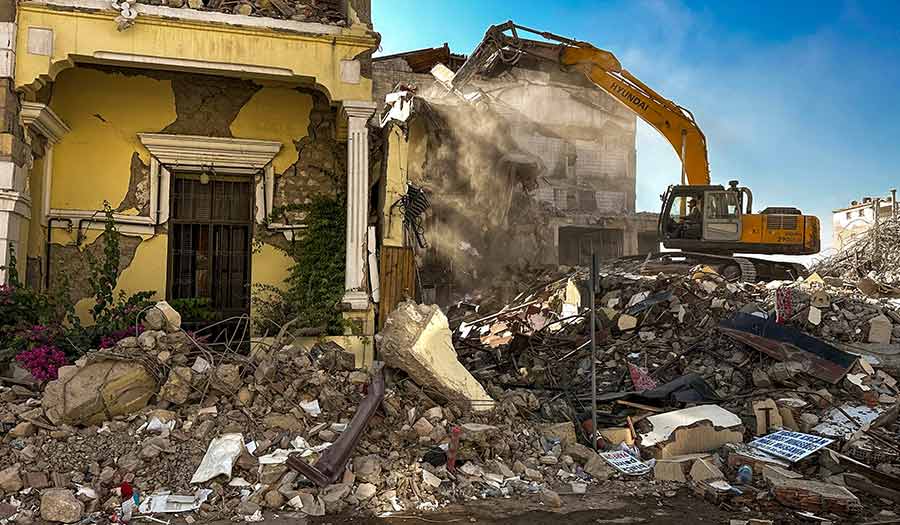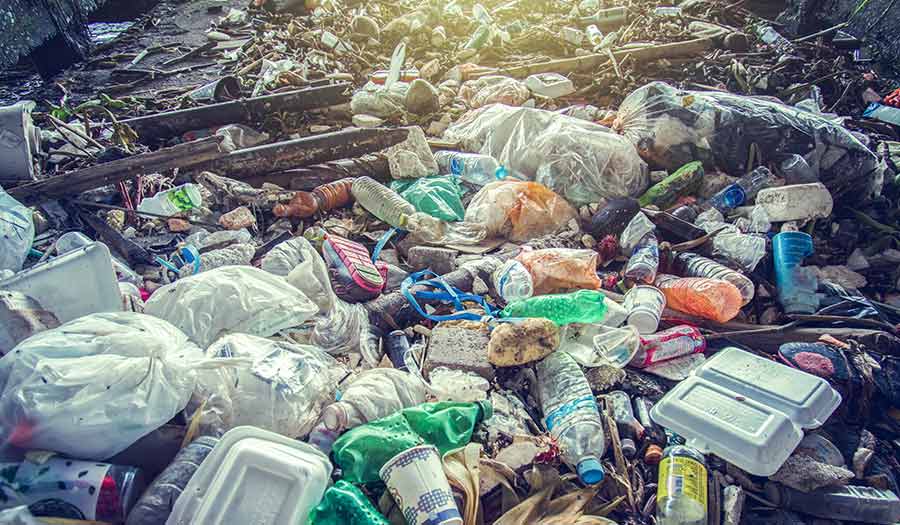 Halil Kahraman/dia images via AP
Halil Kahraman/dia images via AP
World News Desk
Learn the why behind the headlines.
Subscribe to the Real Truth for FREE news and analysis.
Subscribe NowISTANBUL, Turkey (AP) – Dust and rubble fill the street as an excavator tears off chunks of concrete from an old apartment building. Bystanders and former residents watch from afar as construction equipment tears down the structure. Among the bystanders is Ibrahim Ozaydin, 30, a former resident. He watches the demolition not with worry, but with relief, as his building was marked by officials as unsafe months ago.
Mr. Ozaydin and his family were shocked to learn that the municipality deemed his building uninhabitable. “We decided to build our own house,” he told The Associated Press as he watched his former home being torn down. “Instead of living in a poorly built house, let us take our own precautions.”
The sight of construction vehicles demolishing buildings became engrained in Turkish minds six months ago, after a devastating 7.8-magnitude earthquake hit Kahramanmaras and 10 other provinces in southern Turkey on the morning of February 6.
Over 50,000 people died, and hundreds of thousands were left homeless, sheltering in tents and other temporary accommodation. The International Labor Organization estimates that some 658,000 people were left jobless. As for the material cost, some 300,000 buildings were damaged. Survivors needed to be rescued, rubble to be cleared and buildings on the verge of collapse torn down.
Yet this latest demolition is taking place in Istanbul, Turkey’s largest metropolis, far away from the earthquake zone. This time the building wasn’t torn down as part of search-and-rescue efforts, but to prevent such harrowing scenes in the future.
The building was occupied only by Mr. Ozaydin and his extended family, who also owned a shop on the ground floor. The family managed to relocate their shop and build a new, sturdier house at a different location, but theirs is an exceptional story in a city where hundreds of thousands of buildings are at risk and property prices are soaring.
Istanbul lies atop a major fault line, one which experts warn could break at any moment. In a bid to prevent damage from any future quake, both the national government and local administrations are racing against time to alleviate the pain of the February quake while also preparing their cities for potential disasters in the future.
However, even preparedness can fall victim to political rivalry: the authorities in opposition-held Istanbul municipality and the national government in Ankara cannot agree on the exact number of buildings at risk of crumbling in the event of an earthquake. But both put the figure at hundreds of thousands.
After the February tragedy, the Istanbul municipality headed by Mayor Ekrem Imamoglu, a prominent figure in the opposition to President Recep Tayyip Erdogan, earmarked for demolition 318 buildings housing over 10,000 people.
Bugra Gokce, an official with the Istanbul municipality overseeing the demolition, said, “We are identifying buildings at risk of collapse and fortifying others, all to reduce the potential loss of life.”
During a heated election campaign right before his re-election to a third decade in power, Mr. Erdogan pledged to construct 319,000 new homes within the year. He attended many groundbreaking ceremonies as he persuaded voters that only he could rebuild lives and businesses.
“It’s easy to say, ‘we are building this many square meters atop a hill’ or ‘5,000 residences are being built somewhere,” adds Mr. Gokce, in an apparent jab at the national government’s urban transformation programs. “We are also doing that. But if you’re not also reducing the risk to existing buildings in the city, it is nothing more than urban expansion.”
Both experts and Mr. Erdogan’s critics argue that the sheer scale of February’s destruction was due to weak enforcement of building codes amidst a construction boom that helped drive economic growth.
Ankara launched several programs aimed at inspecting damaged buildings both in and outside the 11 provinces hit by the earthquake. Meanwhile, victims have been offered both financial aid and a chance to resettle in public housing projects built by the Housing Development Administration of Turkey, or TOKI.
Although many promises were made by both the ruling party and the opposition in the leadup to the elections in May, those still in the earthquake-affected provinces are demanding faster action.
Lawyer Mehmet Ali Gumus in Hatay province, one of the worst hit by the earthquake, told The Associated Press that people were starting to lose hope. He said there were no signs of reconstruction in Hatay, and that the emergency shelter situation in Antakya, Hatay’s most populated city, was deteriorating by the day.
People are living in metal shipping containers and tents in sweltering heat that can reach up to 107 degrees Fahrenheit without any access to air conditioning. Residents must also contend with flies, snakes and other wildlife while living outdoors, according to Mr. Gumus.
Another health risk is the rubble from collapsed buildings, which is being dumped on farmland, shores, and even right outside encampments where survivors are staying. “Everyone around me says that we survived the earthquake, but they’ll be dealing with cancer in 5-10 years because of the asbestos [from the rubble],” added Mr. Gumus.
In a social media post on July 15, the Hatay governor’s office stated that levels of asbestos in the rubble are safe and below the “regulatory limit.” Results showing low amount of asbestos taken from samples collected in debris dumping grounds were also posted.
While Hatay residents deal with the elements and other environmental hazards, their future remains uncertain.
“There were concrete statements before the elections, but afterwards we stopped hearing anything concrete,” continues Mr. Gumus, claiming that the government has not committed to securing new houses for victims or even to fortifying their existing residences. “Six months after the disaster we should be talking about newly built residences, not lines of people waiting for water,” he adds.
Another Hatay resident, Bestami Coskuner, was leaving for the western province of Izmir because of the power cuts and water shortages in his hometown.
“Tap water is not potable, but people use it to wash. Pipes burst daily, and power is cut two or three times a day,” Mr. Coskuner told The Associated Press. He said water was rationed, and some who drank from the tap came down with serious illnesses.
“You can’t easily drink water. In a place where you can’t easily drink water, how are you going to make any decisions? Even bottled water tastes bad in Hatay,” he added.
Victims of the earthquake have already had to deal with the aftermath of a disaster, the worst cost of living crisis in decades, and a highly polarizing election. They’ll have only had a brief break from politics as Turkey heads to hotly contested municipal elections in March. Mr. Erdogan, fresh off his victory in national elections last May, has vowed to take back the metropolitan cities he lost in 2019.
One of Mr. Erdogan’s campaign strategies had been a focus on providing housing and aid in the earthquake regions. The government made sure to provide amenities, shelter and financial aid for earthquake victims.
His perceived support for the victims was one of the factors that enabled Mr. Erdogan’s party to hold on to power in most of the provinces hit by the earthquake, despite accusations of being responsible for the devastation with his lax enforcement of building codes and the perception of poor emergency response by the government.
Experts like professor Naci Gorur, a geologist and member of the Science Academy, have been warning of a potential earthquake in Istanbul and other provinces for years. He told the Associated Press that the “steps taken were far outweighed by those not taken,” and that Istanbul is not ready for a potential earthquake with the current state of structures and building codes.
Mr. Gorur described the soil in the affected regions as causing buildings to “resonate,” making it even more difficult for such structures to stay intact during earthquakes. The quake occurred in a seismically active area known as the East Anatolian fault zone, which has produced damaging earthquakes in the past, such as the 7.4 magnitude quake near Istanbul in 1999, in which an estimated 18,000 people died.
“We could have prepared the whole of Turkey for an earthquake, not just Istanbul, if we had started working with the ministry to make our at-risk provinces earthquake-resistant. If we had distanced ourselves from politics, if policies were not left to the whims of new administrations, and if there had been a serious budget and determination,” said Mr. Gorur.
“I have no doubts as to government’s good intentions, but if you are going to do something, do it properly. You don’t rush things like these,” he said, adding that instead of rushing permanent buildings, the government should have focused on maintaining temporary residences while conducting proper studies for the building of permanent structures which comply with “scientific principles.”
- Personals
- RELIGION
 Man’s Insoluble Problems—Why?
Man’s Insoluble Problems—Why?
More on Related Topics:
- Residents Slog Through Flooded Streets, Clear Debris After Hurricane Milton Tore Through Florida
- A Week After Helene Hit, Thousands Still Without Water Struggle to Find Enough
- Hurricane Helene Kills at Least 90 in U.S., Homes and Memories Washed Away
- Portugal Declares a State of Calamity as Wildfires Rage Out of Control
- During Brazil’s Worst Drought, Wildfires Rage and the Amazon River Falls to a Record Low


